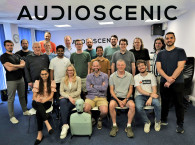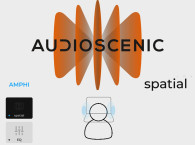
The S3A Project
Audioscenic started in 2015, when I met Professor Filippo Fazi, working together on the S3A audio project. The S3A program was a 5-year UK research project that aimed to bring spatial audio into people’s living rooms and develop innovations that would increase the in-house adoption of spatial audio consumption, which at that time was stagnant due to the slow sales of home cinema systems, mainly caused by surround home systems being complex and bulky and hard to set up. This was in 2015, so ambisonics for headphones and virtual reality (VR) had not yet arrived on the market.

At that time, I had just graduated with a PhD in personal audio, specifically experimenting with using loudspeaker arrays to create boosted audio zones to increase speech intelligibility for hard of hearing TV viewers. Filippo Fazi was the principal investigator of the S3A project at the Institute of Sound and Vibration Research (ISVR) at the University of Southampton.
The ISVR had a long tradition with the development of crosstalk cancellation systems, dating back to the early 1990s. Filippo and I were both fascinated by the breathtaking spatial audio performance that a good crosstalk cancellation system could provide. We were driven by the idea of a soundbar that could provide full 3D audio as a method of bringing spatial audio to the people. A soundbar was something more appealing to put in the living room than a full surround setup, and this idea had been tried previously commercially by companies such as Opsodis and Comhear.

Until then, crosstalk cancellation systems were designed to work with a single, fixed, sweet spot. This was a real problem as they were only working effectively if a user was placed exactly in front of them. This was not ideal, as consumers would not widely accept such a system and therefore crosstalk cancellation systems were only used in academic and niche, enthusiast applications.
One of the main research methods of the S3A program was to use computer vision to locate users and then steer the sweet spot of audio systems accordingly. This is what I did with the crosstalk cancellation technology, by combining a Microsoft Kinect with a loudspeaker array, I built one of the first user adaptive spatial audio arrays (the Sound Virtualizer, which was featured in one of the first issues of The Audio Voice newsletter that year).

One of the main advances achieved by the technology developed by me and Filippo was simplifying the signal processing required to implement a multichannel crosstalk cancellation using a minimum amount of processing power, making implementation of the technology in small embedded systems possible.
First Investor Meetings
In 2016, we patented the technology with the help of the University of Southampton. Back then, I was increasingly motivated by the idea of finding a way to take the technology outside of the laboratory and implement it as an accessible consumer product.
One of the things I wanted to avoid is having the invention just be published as a Journal Paper and then forgotten, collecting dust at the University labs, as happens with much academic research. And then I saw an opportunity when we were given £35,000 by the UK government to explore the commercialization of the technology and conduct market research.
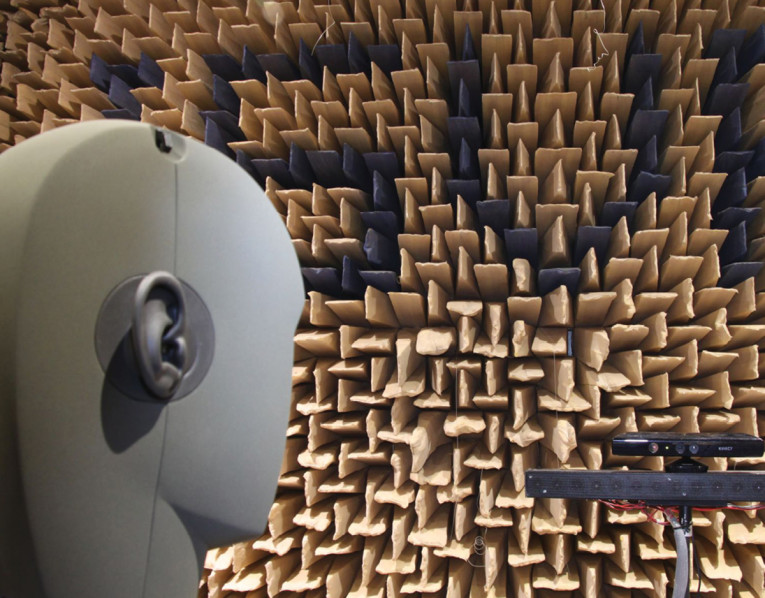
Back then I built a very early prototype by myself at the University workshops. It traveled the whole world and we were able to show it to the global audio industry. But even though it was still a prototype, it was very encouraging to do demos at CES and hear visitors saying that it was the best demo they had seen at the show...
Coming back from CES in 2017 with such good feedback gave us the required motivation to continue developing the technology. It was sometime later that year when I was introduced to Dr. Lee Thornton (who later became Non Executive Director of Audioscenic). Lee Thornton saw great potential in the technology and started digging into the possibility of funding Audioscenic to take the technology out of the University and form a startup company.
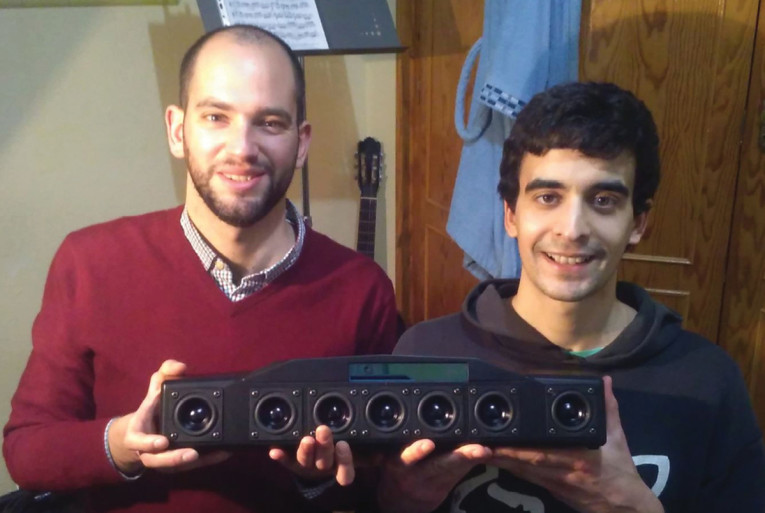
This was also a major breakthrough, because it was the first time that we made our technology run inside a Raspberry Pi and so it became our minimum valuable prototype. Andreas Franck, later our software lead, helped me quite a lot with the real-time audio implementation. Charlie House and I also built a two-way 28-source array that we named “Pata Negra,” which is a Spanish synonym for the best quality ham one could obtain. This was a real achievement as we were able to improve the sound quality of our early university made prototypes — which in turn began opening doors for us in the audio industry.

These developments led us to have the first prototype of our gaming soundbar design, which we built for CES 2018. My cousin helped me do the industrial design, and the prototype was built using Intel RealSense development kit with an UP board. I remember spending Christmas in my father’s garage finishing the electronics and painting the enclosure.
Transitioning Audioscenic to be a fully operative company was a slow process and it was hard initially to advance in both technical and commercial terms as we were still developing our team. It was mainly me with the help of some interns, since Filippo was busy with the University. However, in 2018, we were introduced to David Monteith, who was to become Audioscenic’s CEO and helped us win a pitch that secured the first round of funding for the company. David Monteith had previously founded and successfully exited a pair of companies that were key to the development of 3D audio in the 2000s: Sensaura and Sonaptic.
The First Year
The team, which now also included Senior Engineer Tyler Ward, traveled again to CES 2019, this time with a prototype that was a small soundbar built as a laptop accessory. It was a long trip and a long show where we were still looking for a way to take the technology toward a product. Luckily, the last meeting of the last day of CES connected us to the technical leads of a Shenzhen, China-based ODM... paving the road for our first commercially oriented prototype.
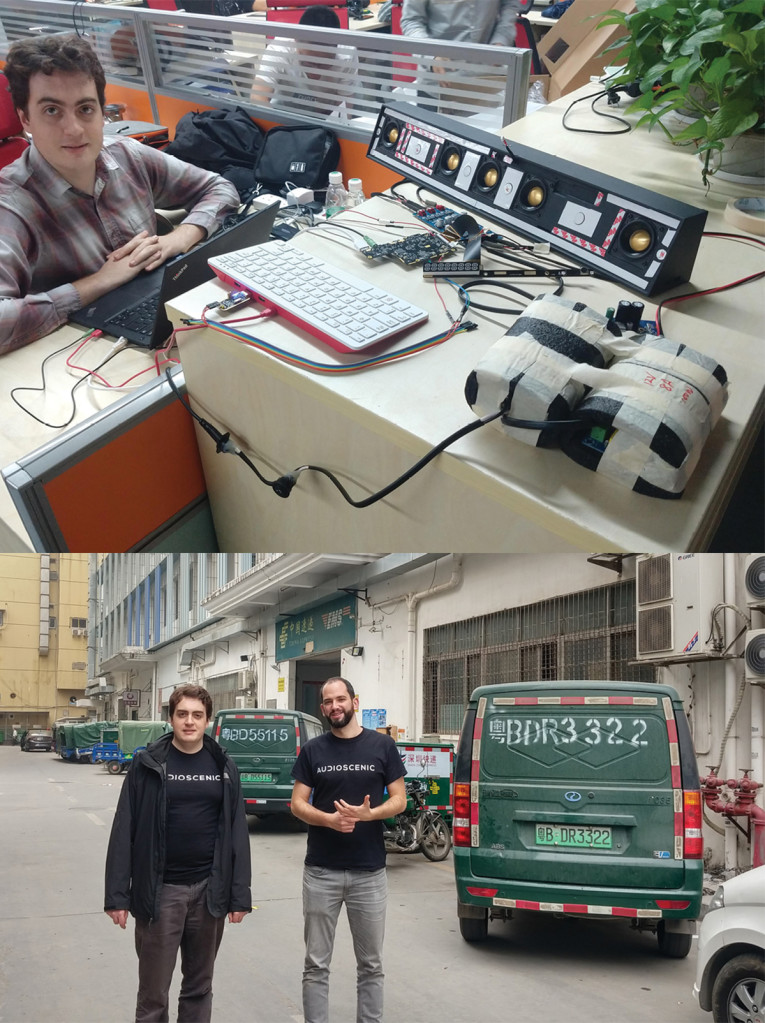
In 2019, Audioscenic was formally founded and soon it grew to six people, with the addition of software engineers Andreas Franck and Joey Laghidze. We built some prototypes of the gaming soundbar and sent it to the ODM so that they could start showing it to their customer base. The year progressed and by Autumn we were working on a reference design for CES 2020, which forced me and Tyler Ward to spend the last two weeks of December in Shenzhen completing the prototype to be presented at CES. The team worked 12-hour days and weekends to make sure the first prototype was fit for a demo!
Although the previously developed prototypes worked well in the lab, obtaining a similar level of performance in a fully production-ready embedded system proved to be tricky! The team was finally successful, and when we arrived at CES, the demo was very well perceived by everyone who visited the ODM booth!
Company Growth in Pandemic Times
We returned from CES 2020 knowing that we had a great show, we had a product with a customer lined up, and we were preparing a pitch to raise more money. Happy days. Little did we know that a pandemic was coming...
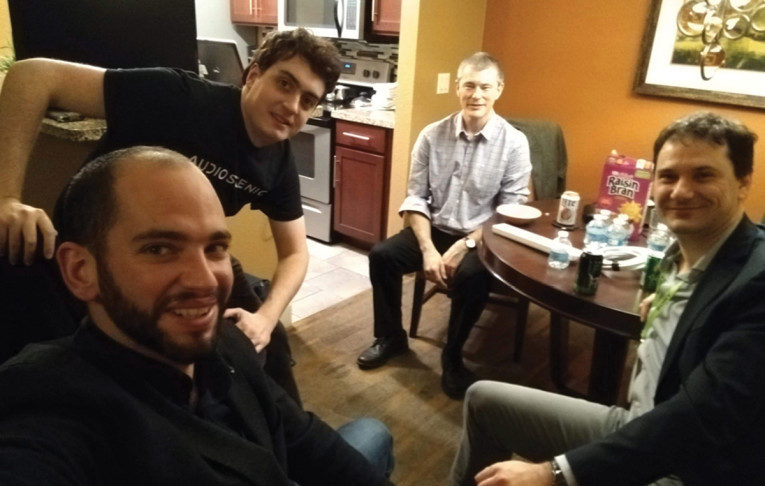
It was March 2020 and the UK along with the rest of the world was going into lockdown, causing a stagnation that really complicated our technical and commercial developments. During those days we struggled, given that our technology is one that you have to hear to be convinced of its performance and it wasn’t easy to do demos remotely! Apart from that, we needed to raise more money to continue funding the business, which we did in October 2020 thanks to an investment from Foresight Williams Technologies to Audioscenic.
To try to ease the pandemic effect, we hired a commercial person to help us in China, and we also developed our hardware development kits (HDKs), which we could ship and loan to customers and collaborators, so they could remotely listen to our technology.

During the pandemic, there were tough times but we continued developing the technology, always with the vision of “creating systems that will automatically adapt to the user’s position.” We were successful in our funding round and added more roles to the team: Daniel Wallace, as R&D lead; Roberto Grilli and Davi Carvalho as R&D engineers; Ria Atara as a third software developer; and Kim Davies as office manager.
From the beginning, the vision of Audioscenic has been to develop audio systems that can give an extraordinary spatial audio experience and that require nothing or little setup by the user. User experience is the primary driver of what we do, and of course, all of this is based on solid theory building on our pedigree from the ISVR. During the pandemic, we kept faithful to this vision so that innovative companies were made aware of our technology.
The hard work invested in the company by all its team members paid off, with the first commercial product based on Audioscenic technology being released at CES2023: The Razer Leviathan V2 Pro. The soundbar, developed in partnership with Razer and THX was the world’s first PC soundbar with head-tracking AI and adaptive beamforming. We consider this to be a great achievement.
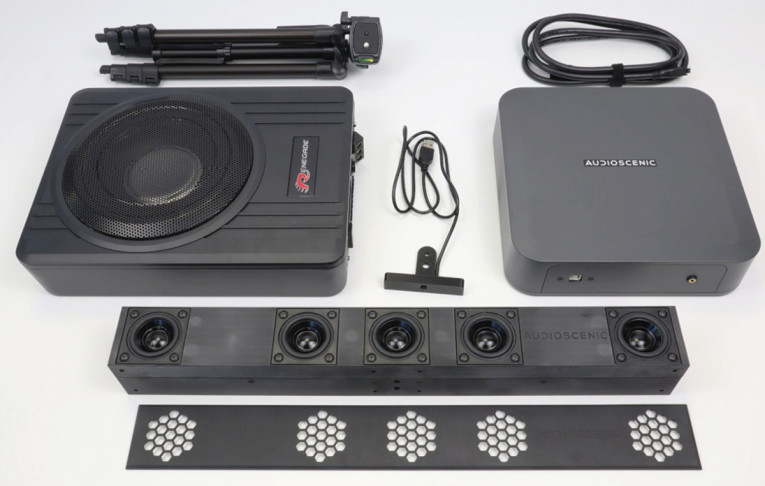
Not only for the company, but for the whole spatial audio industry in general: a speaker-based system capable of rendering high realism spatial audio; and not only providing an alternative to headphones, but able to provide an immersion and externalization far superior to headphones.
The Razer Leviathan V2 Pro obtained 12 best in show awards at CES 2023 and Audioscenic was given the Best in Show tech mention by audioXpress!
Beamforming, Automotive, and The Future
It has taken much time and hard work since Filippo and I started developing the technology in 2015, but the perseverance has paid off and the first product based on the technology is now on the market, with the aim of bringing spatial audio to people in a practical and user-friendly way. A vision that, despite a global pandemic and wars, Audioscenic has managed to push forward as a company.
The technology that Audioscenic has developed allows for any kind of user-adaptive DSP using combinations of speakers, so it can also be applied to other uses apart from crosstalk cancellation. For example, beamforming or the creation of independent listening zones for automotive, both areas that are currently being explored both technically and commercially and that are also expected to become products in the following years.

Right now, Audioscenic is a growing startup and many others have joined its team including George Howell, Balu Raj, Yury Ushakov, Dimitris Zantalis, Jose Cappelleto, and Jago Reed-Jones. This is creating a great future for Audioscenic, where we see ourselves providing technology for a variety of use cases that does not involve wearing headphones. At Audioscenic, we want to believe that “the future of sound is spatial and that it will be consumed either with wearables or with an Audioscenic enabled system.” As a company, we are now a happy family with a presence on various continents that will fight and strive to continue growing and spreading its vision! aX
Resources
Audioscenic, www.audioscenic.com
“Audioscenic Partners with Razer and THX to Launch Desktop Soundbar with 3D Beamforming Technology and Head-Tracking AI,” https://audioxpress.com/news/audioscenic-partners-with-razer-and-thx-to-launch-desktop-soundbar-with-3d-beamforming-technology-and-head-tracking-ai
J. Martins, “Audio Innovation Never Stops,” The Audio Voice, Issue 109, December 2016.
The S3A audio project, https://cvssp.org/projects/s3a
The Audioscenic team now in 2023.
This article was originally published in audioXpress, June 2023
 About the Author
About the AuthorMarcos Simón is the Co-Founder and CTO of Audioscenic limited. He is a world expert in sound field control and array signal processing who became an entrepreneur to change the way people currently consume spatial audio. Marcos graduated in 2010 from the Technical University of Madrid with a B.Sc. in telecommunications. In 2011, he joined the Institute of Sound and Vibration Research, where he worked with loudspeaker arrays for sound field control and 3D audio rendering and also in the modeling of cochlear mechanics. He obtained his Ph.D. title in 2014, and between 2014 and 2019 he was part of the S3A Research Program "Future Spatial Audio for an Immersive Listening Experience at Home." In 2019 he co-founded Audioscenic for the commercialization of innovative listener-adaptive audio technologies, where he currently works as Chief Technical Officer. Since the creation of the company, Marcos has been leading the vision of Audioscenic and established himself as a nexus between the commercial and technical world for the start-up; making sure that the technology is continually evolving and that the customers understand exactly what the technology makes possible. Marcos combines his innovation passion with love for cooking, sailing and DJing electronic music.



